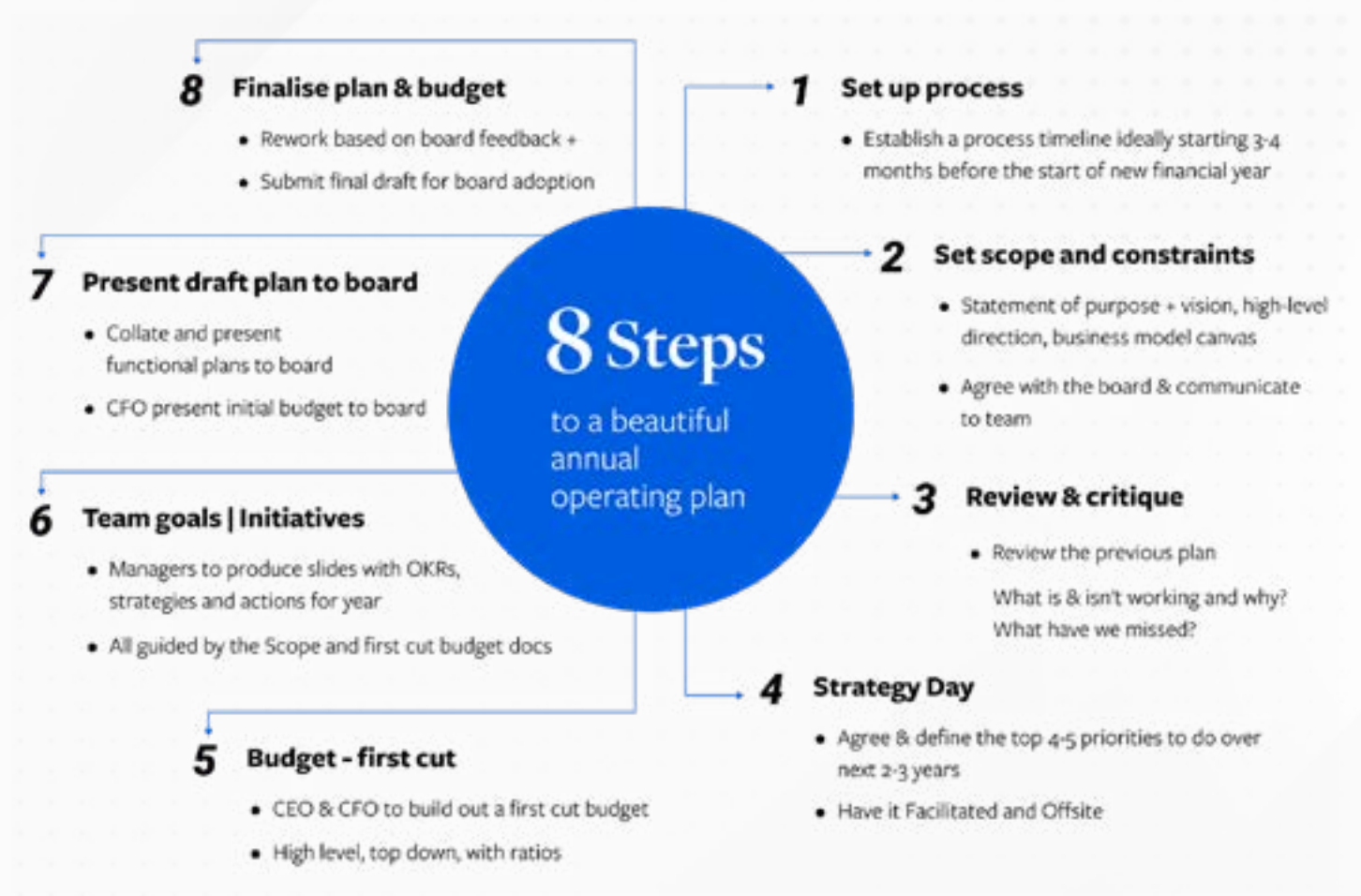How to build your annual operating plan
An annual operating plan is a prized document – it’s the blueprint for building your organisation in any given year. You wouldn’t build a house without architectural drawings. Unfortunately, many SME CEOs run their organisations with only a sketch of what they are building. This guide is aimed at CEOs of commercial and not for-profit organisations with revenues between $2M and $40M and a functioning management/leadership team (i.e., 3+ managers) who don’t have a strong track record of strategic/operational planning. If your organisation is smaller, absorb the principles and scale down the process to suit your resources.

The 8 steps for building your annual operating plan are:
1. Setup process
The most important thing is to start. It is easier to start and alter a draft than stare at a blank canvas. You’ll find a process framework in the downloadable guide. It will help you to ask the right questions. You must also prepare early and have facilitate the steps well. This article assumes your business understands its reason for being (purpose/vision). This is a guide on ‘how to’ get there, not ‘why’ you are on this journey.
The first step is to establish a basic plan and timeline, which gives you the confidence you’ll cover the essentials and provides a guide to your leadership team and board.
2. Set scope and constraints
It seems logical and obvious that before heading forth on any planning exercise the end point of the journey should be clear. But, sadly, this is often not the case. It is not for management alone to determine what success looks like for the organisation; that sits with the board as the representatives of the owners.
The board own the statements of intent. These include purpose, (which is interchangeable with vision), the mission (long-term goal), high-level direction.
This is the board’s strategic thinking process. These statements can be formed in consultation with management, and for smaller businesses, the board and management are often the same. However, the ownership still rests with the board.
Statements of intent must precede any planning by the executive team. The board makes the intent of the organisation clear, thus creating the framework within which the planning is to occur.
Having made clear what is to be achieved (ends), the board will also have outlined any constraints on management in consideration of options (means to be used).
Setting scope is therefore a two-phase process:
- To secure any new or particular strategic mandate thereby setting the parameters of the scope by the board
- To communicate that scope and associated constraints to the leadership team as a basis for operational planning
The leadership team can then develop operating plans and budgets that are consistent with the direction agreed by the board.
Mature organisations have strong foundations already in place and a natural rhythm for reviewing strategic priorities that can feed into the annual operational planning process. Here, we’ve assumed a lower level of maturity and outlined a strategy day as part of the annual planning process – see step 4. If you don’t have any foundations in place at all, see expert tips in the next section.
Put together a short briefing document that outlines the scope of the planning exercise including:
- a reminder of the organisation’s vision, purpose and high-level direction
- key constraints on the organisation, eg. available capital
- business model canvas (your business outline in a single page)
- objectives and key results (OKRs) or business scorecard (already in play)
- a SWOT analysis (strengths, weaknesses, opportunities, threats).
Confirm this with your board, prior to sharing with your leadership team.
Send out the summary to your leaders and then meet with the group to highlight key aspects and allow for questions and concerns to be handled. It serves as a guide and input to your strategy day.
3. Review and critique
Capturing the learnings of the last year is a vital part of the annual planning process. An honest review of the previous plan and your current position should not be treated casually. Organisations that do not incorporate learning loops are prone to continue making the same mistakes. Ask the team: “what is succeeding, what has failed, what have we missed and why?”.
A simple hack is to take the prior year’s documents and convert the goals and objectives into a three-column table with the target in column 1, the actual results in the second column and commentary in column 3.
4. Strategy day
Reviewing and confirming your foundation stones prior to producing your operational plan will lead to a stronger, more professional operating plan. Think of it in two parts:
1. A foundation comprising:
- Purpose (or mission)
- Vision
- Values
- Market (who you are addressing)
- Core value proposition
- Positioning in the market
- Competitive advantage
2. The top 4-5 priorities, which the board wants achieved over the next 2-3 years
Part 1: should exist and if not, should be produced prior to the annual planning cycle. It serves as an ongoing reference for leadership team and board for the annual planning process.
Part 2: should be refreshed/reviewed annually and serves as a natural input to the annual planning process.
The key is to develop the right context (with supporting resources) to be considered in advance (see above) to be debated by the right group in a relaxed environment.
Use the key supporting documents, especially the SWOT and environmental scan as prompts to begin debating what those top 4-5 priorities might be. A skilled facilitator will help enormously to draw out ideas from the entire group and prioritise the list.
For example, the top strategic priorities for, say, a $10M ISP business in 1999, facing significant monopoly competition and technology changes, might have been:
- Migrate revenue streams away from low-profit commodity products (i.e. residential ADSL) so that 80% of revenues are in higher-profit products like datacentre and website hosting by 2001.
- Identify long-term technology trends and choose sustainable market space by 2003, i.e. web hosting or identify an exit pathway if there is no way to meet the shareholder goals.
- Maintain existing operational excellence and staff engagement as measured by … to June 20XX.
Learn how to review the progress of your strategic and operating plan
5. Budget first cut
Choosing to produce your annual plan OR your budget first is something of a chicken-and-egg scenario. Do you create your plans and then cost them or do you create a budget first and fit your initiatives into the available cash? And how much expenditure do you allow to be covered by projected revenue growth?
There's no right answer.
My preference is for the CEO and CFO (head of finance) to create a fast, simple, top-down initial financial forecast as a guide to the team. It doesn’t mean the team can’t later argue for more or less expenditure or more or less bullish revenue projections. The initial constraints will, however, allow functional leaders to size up a plan based on an expected financial model.
Try and keep this budgeting process focused on the smallest number of levers that have the largest amount of impact. For instance, in a high-growth business this will be the revenue growth rate and associated investment in customer acquisition and the desired investment in product and/or new market development. Try and get ahead of the curve on these high-impact items. Ways to do this might be reviewing industry benchmarking, conversations with key directors and advisors, or capital allocation discussions with the board. At the very least, put a peg in the ground with a starting suggestion – feedback from the team and the board will shape your view.
Everything else can be handled via expenditure buckets and simple ratios. For instance, general administration can be calculated as a single line based on a percentage of revenue.
For example, last year’s G&A might be $1M and 10% of revenue. You know you’re increasing the overall organisational headcount by 20% this coming year and that you also expect efficiencies. You might then settle on G&A as 9% of revenue, which boosts the gross budget line by several hundred thousand. Do no more work than that at this stage and certainly no detailed line-byline budgeting.
Finally, the form of the initial budget should be very simple – a page of key numbers and a page of related graphs.
6. Team goals - initiatives
With strategic direction emerging and an indicative budget to hand, it’s time to delegate the next phase of planning to your functional team leaders: marketing, sales, production, operations etc.
It’s better for these leaders to create their annual plan than for the CEO to lead. Buy-in is significantly higher if the person responsible for executing the plan writes it. The CEO’s role is one of inspiration, coach and co-ordinator.
7. Present draft plan to board
Presenting your annual plan to the board should be relatively straightforward as they have already provided your scope and constraints and participated in a strategy day. The annual plan should be a natural out-working of the broad directions already agreed to with your board.
Go about the process in this way:
- Create a single operating plan presentation.
- Insert your organisational purpose and vision as opening slides to orientate the reader to the big picture. Consolidate the functional goals and initiatives produced by your team leaders and insert these into the presentation. Add your initial budget.
- Send to your board as pre-reading material.
- Have each team leader present their function’s plan on the day. Engage in open discussion and solicit feedback from the board. Openly acknowledge constructive feedback and intent to incorporate into the operating plan. As CEO, take the opportunity to set the scene and ask questions throughout the process. Be the chief solicitor of feedback.
- Have your head of finance present the initial budget, focusing on the current charts and trends.
- Task the facilitator with summarising feedback and key take-aways.
- Avoid the need to finalise all the key questions raised on the day. Reserve the right to receive the feedback and incorporate it into the final plan after appropriate consideration.
8. Finalise plan and budget
Consider feedback soon after the presentation day and absorb what makes sense into the operating plan and budget within a week. Upgrade the initial budget into a final version including:
- all salaries and expected increases
- review and acceptance by functional team leaders
Circulate the document to the board for final sign-off. Upload the final version into a central repository accessible by all team leaders.
Where to next?
- Download the full copy of How to build your annual operating plan guide.
- Explore the Operating Plan Summary template for your own board
- Schedule a demo with our team today and begin to experience a whole new way of meeting.
Share this
You May Also Like
These Related Stories

How to create your annual operating plan: FAQs

How to review the progress of your strategic and operating plan



